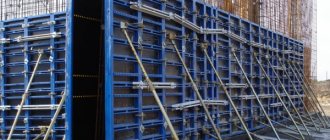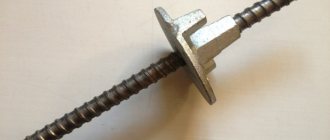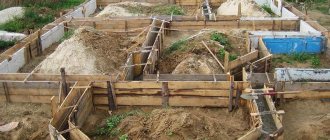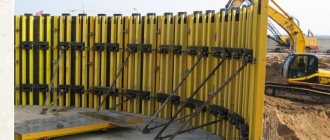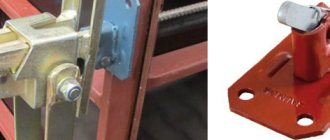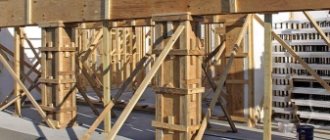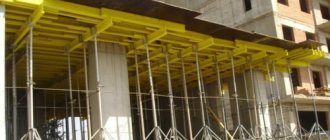The construction of monolithic structures requires a lot of time and effort, so new technologies are constantly appearing in the construction industry that speed up the process of pouring concrete. One of them is sliding formwork (or, as it is also called, movable formwork). Thanks to this type of construction, a strong and reliable structure can be erected in a short period of time. The finished structure will have good strength, heat and sound insulation characteristics.
Let us take a closer look at the design of sliding formwork, the feasibility of its use and the installation method.
Rules for pouring formwork
Let's consider common types of concrete work in private construction, for which you can make formwork yourself:
- Pouring a blind area, garden path, car area and other similar “horizontal” concrete work can be done in formwork made of new or used red brick. Brick formwork for pouring concrete is laid out along the contour of the future structure in a shallow trench (50-60 mm) at the building level. The space between the brick “contours” is filled with concrete. In this case, the brick remains in the trench and performs the function of protecting the contours of the concrete structure from destruction.
- Pouring the foundation of the building. As a rule, this is a strip foundation poured into a trench of the appropriate depth and width. In this case, the function of the main formwork is performed by the walls of the trench. If, for one reason or another, it is necessary to raise the upper section of the foundation above the zero point (soil surface), concrete is poured into formwork made of boards at least 25 mm thick and bars 40x40 or 50x50 mm. Shields are made from boards and bars. The panels are installed along the outer and inner perimeter of the foundation and are connected to each other with steel pins. Concrete pouring work is in progress. The air temperature will tell you when to remove the formwork after pouring concrete. At an air temperature of 20-25 degrees Celsius, the structure is dismantled after 3-4 days. At a temperature of 5-10 degrees, stripping is carried out in 7-10 days.
- Pouring concrete walls. In this case, homemade adjustable formwork is used from wooden panels about 70 cm high, first supported by the base of the building. After pouring and setting the first “belt”, the sewn sheets are rearranged higher and rested on the already poured “belt”, and so on until all the walls are “forced”. The outer shield belt is connected to the inner belt using two rows of steel threaded adjustable pins. In this case, the lower row of studs serves as support for the base and the next “belts” of the wall.
- Filling the ceiling. Homemade formwork for pouring a floor slab consists of two structures. These are wooden panels, fixed in one way or another along the outer perimeter of the walls and an additional horizontally located wooden panel, placed indoors at ceiling height using powerful logs. This is a rather complex, but viable design. The main problem is to correctly and reliably position the horizontal shield. Otherwise, it will either fall under the load of concrete or collapse.
Application in private construction
The main purpose is associated with the construction of tall buildings or monolithic structures with a minimum number of openings: chimneys, silos, water or television towers. Thus, the installation of sliding metal formwork with automatic jacks is more suitable for industrial construction rather than private construction. But the system quickly adjusts to any task, including restoration work. It is allowed to use a sliding formwork structure to repair the walls of wells.
In individual construction, the method itself is more popular, that is, lifting the formwork panels vertically by hand. This allows for seamless filling of wells and other tanks, monolithic walls from the foundation. At the same time, in all structures without exception, a reliable reinforcing frame is placed inside, enhancing the strength and reliability of the building. At home, it is more difficult to carry out continuous concreting; the poured area is between the panels for more than 1 day (until the hardening state is acceptable by standards).
Instructions for installing formwork for a well
This method is recommended for use when concreting a well; work is carried out during the groundwater decline season: from August to October. All necessary materials, tools and a site for placing the excavated soil are prepared in advance. The recommended well layout includes:
- A concrete “knife” is a wider concrete ring, sharpened from the inside.
- Walls (not always round).
- The bottom filter is a cushion of crushed stone and sand.
- Area to place the pump (optional).
- Underground waterproofing pavement made of roofing material or film.
To make sliding formwork, you will need steel panels with a thickness of at least 2 mm; wood is suitable for the frame and other parts. In fact, this is a one-time design; the required dimensions and shape are achieved by connecting the sheets with screws or nuts. Fastening elements should not fall into the concrete solution; they should be removed outside.
The recommended internal diameter of sliding formwork for a well is 80 cm, external - 100, wall height - 50–60. At a given height, the sheets are fixed with metal strips, and wooden blocks of the same length (along the width of the walls) are installed between them. When the water flow is low, changes are made to the circuit: the lower section is made with slots into which filters will subsequently be installed.
The work is carried out in stages:
- Digging a hole.
- Manufacturing and placement of sliding formwork.
- Pouring a concrete “knife”, the upper edge of which must be strictly horizontal.
- Concreting of rings with mandatory reinforcement.
- Backfilling of soil (it is allowed to bury a well that is not fully completed).
Installation and pouring of concrete is easy to do yourself; for ease of work, it is recommended to use a stepladder. To make a concrete beveled base, cut boards are placed in the formwork. Reinforcing rods or wire are placed vertically and horizontally, like a wicker frame. Concrete is selected with the highest strength; the instructions for the cement must be checked (the recommended grade is not lower than M500). A simpler option is square-shaped sliding formwork, for example 100x100 cm, with this design it is easier to perform reinforcement.
What do the masters say?
Tips and tricks:
1. When carrying out work at home, you should find a replacement for a construction vibrator; a sealed piece of iron pipe of suitable diameter is ideal for compacting the solution.
2. Internal reinforcement is a mandatory nuance of the technology; the optimal effect is achieved when using corrugated steel rods. Horizontal reinforcement of wells with wire is carried out every 30 cm. The internal frame is protected from corrosion: the rods should not be located close to the surface (from 15 mm and deeper, ideally in the middle of the wall).
To decide how to make formwork with your own hands, it is better to study video materials.
Sliding formwork technology
When using sliding formwork, it is necessary to use high-quality concrete mixtures. To ensure a continuous pouring process, it is necessary to simultaneously ensure timely hardening of concrete in the lower layers and its liquid state in the upper ones. Concrete is poured into the formwork continuously. The next layer of concrete mixture must be poured and compacted before the previous one sets. If for some reason the process needs to be interrupted, then special additives are added to the mixture to slow down the hardening process. Each subsequent layer of concrete is poured with the same thickness, which ranges from 10 to 20 centimeters. It is this thickness that allows for the endurance of the technological process. If the walls of a building are erected in areas with a cold climate, then individual heating of the concrete is used to ensure continuity of the process. Heating of a concrete structure can be carried out by laying electric heating cables or using infrared heaters. In addition to continuously rising formwork, step-by-step reinstallation of the structure can be used. It consists of tearing off the panel structure from the frozen wall and then installing it at the next level of pouring. In this case, the formwork constantly moves up and down with the same amplitude to prevent the panels from sticking to the concrete.
Types of removable formwork
In construction, several different types of formwork are used for monolithic construction. The choice of option is carried out taking into account the design of the structure being built.
Large-shield
The use of large-panel formwork is advisable when constructing large objects. The set consists of large-area panels that are structurally connected to supporting elements.
For ease of use, the shields are equipped with special scaffolds for moving workers, and a system of jacks is used to level the height.
The use of this equipment allows you to quickly assemble formwork forms of the required configuration. The disadvantage is the difficulty of ensuring casting quality in the corners of the molds. In addition, assembly requires the use of lifting equipment.
Small shield
Sets of small panel formwork are used for the construction of a wide variety of structures, including small architectural forms. This option is suitable for casting vertical, inclined and horizontal shapes of various shapes.
Consists of panels weighing less than 50 kg, as well as supporting and fastening elements. If necessary, the panels can be joined, enlarging the structure vertically.
An important advantage of this option is maximum technological flexibility, the ability to assemble manually or using light cranes. Disadvantages include the high labor intensity of assembly, as well as the need to use additional measures to ensure high quality surfaces of cast walls.
Lifting and adjustable
These are collapsible structures, specially designed for the construction of vertical structures with a height of more than 40 meters with a constant and variable cross-section. The package includes external and internal working floor panels, jacks mounted on frames, and drive stations.
As the concrete solution hardens, the formwork is raised higher by jacks. The advantages of the equipment are high construction speed and maximum technological flexibility.
The disadvantages include the increased complexity of constructing floors, as well as the high technical complexity of the equipment. Due to the latter circumstance, highly qualified workers are allowed to work with this type of formwork.
Volume-adjustable
Volumetric adjustable formwork consists of blocks, which, after assembly, form formwork in the shape of the letter “P”. Used for simultaneous concreting of walls and floors of premises. This provides additional strength to buildings. The disadvantages include:
- relatively little technological flexibility;
- The equipment is difficult to install, so it is necessary to use highly qualified labor.
sliding
Sliding formwork is mainly used for the construction of tall monolithic structures of small diameter, for example, chimneys. The principle of operation is the ability to move formwork forms vertically upward without interrupting the concreting process. This equipment allows you to do without dismantling the structure and installing it in a new location. The shields simply move up.
The disadvantage of the equipment is its high cost compared to collapsible formwork kits. However, in some cases, using this option is cost-effective. Another important circumstance is the need for continuity of the pouring process, which is why the work has to be carried out in three shifts.
—> —>Friends of the site —>
Buy concrete in Nizhny Novgorod: 8-(831) 212-97-88 and +7963 232-97-88
The classification of methods for constructing buildings made of monolithic reinforced concrete is based on the method of constructing load-bearing structures, since other parts of the building are made in the usual way using different construction methods. The most common industrial methods for constructing buildings from monolithic reinforced concrete by concreting are:
I - horizontal and vertical structures using fixed formwork (large-panel, volumetric adjustable);
II - vertical structures using movable (sliding) formwork, and horizontal - using fixed (large-panel or volumetric adjustable) formwork or prefabricated reinforced concrete products;
III - horizontal structures in the form of a package of floor slabs at ground level and their subsequent lifting with jacks along prefabricated steel or reinforced concrete columns to design elevations (a method of lifting floors when the arrangement of floors is carried out at design elevations).
IV - horizontal structures in the form of a package of floor slabs and the arrangement of floors at ground level, followed by raising the finished floors to design levels using prefabricated steel or reinforced concrete columns (floor lifting method);
V - in the sliding formwork of stiffening cores and the execution of the remaining structures of the building from prefabricated elements;
VI - in the sliding formwork of stiffening cores and suspension of floors (floors) to them using cables (buildings of a suspended structure).
Construction in volumetric adjustable formwork can be carried out by removing it after concreting along the transverse axes of the building, moving the volumetric formwork along the building (Fig. 3.1, a) or using vertically removable formwork used for concreting only the vertical structures of the building (Fig. 3.1,6).
Rice. 3.1. Construction of a monolithic building in volumetric adjustable formwork by moving it
Construction in large-panel adjustable formwork is carried out using elements whose dimensions correspond to the height of the premises and the distance between the load-bearing walls. The formwork of walls and ceilings is mounted separately. The wall formwork panels are installed in the design position and fastened together.
As a rule, internal transverse and longitudinal walls and ceilings are erected using large-panel formwork. The outer longitudinal walls are not concreted, so as not to interfere with the removal of the formwork panels from the ceiling; after concreting the monolithic structures, the outer wall panels are hung. A combination of monolithic external and internal walls with prefabricated floors is possible.
One of the main positive properties of large-panel and volumetric formwork is their immobility during laying and hardening of concrete, which makes it possible to obtain smooth surfaces of walls and ceilings, and also creates conditions for the use of relief formwork. With large-panel and volumetric formwork, monolithic frame units are formed for connecting load-bearing walls with floors, as well as spatial systems that ensure high rigidity and stability of the structure. Large-panel adjustable formwork allows the construction of multi-storey buildings with both compact and developed plans, both low-rise and multi-storey, entirely monolithic and with extensive use of prefabricated elements.
The main disadvantage of large-panel formwork is the need for careful installation and alignment of each panel. Volumetric adjustable formwork eliminates this disadvantage, but it is more complex and heavy and limits architectural and planning solutions.
Construction using sliding formwork involves the continuous joint lifting of formwork and suspended scaffolding by jacks. For formwork, panels with a height of 1.0 - 1.2 m are used.
Do-it-yourself concreting of walls
The use of a sliding formwork system for the construction of walls of private houses with your own hands is impractical. These systems are not used on small objects due to the high operating cost of the formwork complex.
Adjustable panels are similar in structure to sliding formwork. This concreting eliminates the use of an expensive sliding formwork system.
Watch the video on how to use adjustable panels in private construction.
https://youtube.com/watch?v=3D8WIJ4pXdE%3F
When rearranging formwork panels, worker labor is used; in other cases, small lifting mechanisms or a truck crane are additionally used. Installation of shields with your own hands begins from the doorway or from the corner of the building. The lower part of the rearranged panels on the upper tier of the walls is secured with ties to the finished part of the monolith.
When the next tier is being installed, the panels are secured with ties to the side section and to the lower tier of the wall. The adjustable structure is moved in such a way as to use the holes remaining at the bottom in the monolith for fastening the ties of the upper tier below.
Features of work
The construction of walls using sliding formwork is regulated by the provisions of SNiP. Plywood, wood, chipboard, aluminum or sheet steel can be used as construction material. Metal panels are more expensive and are recommended for use if it is planned to erect a large number of buildings of the same type - 10 or more.
Using sliding formwork at home
Panels used in sliding formwork can be made in the form of flat or curved structures, depending on the architectural features of the project. Their height is usually from 1 to 1.5 m, which is most convenient when working with them. To avoid jamming of the system, external and internal panels are installed at a slight slope to each other. The taper can reach about 0.5-1%, i.e. the lower part of the sliding formwork should be 5-10 mm wider than the top.
The width of the walls being erected also has limitations. According to the provisions of building regulations, the minimum permissible thickness of walls erected using the “sliding technology” should be over 12 cm, and for load-bearing columns - 25 cm. In this case, when lifting the sliding formwork, it is possible to avoid the formation of a gap between different layers of concrete pouring. A layer of concrete that is too thin and, accordingly, too light can be carried upward by the raised shields due to the force of friction. To avoid this, the internal shield surfaces are also coated with compounds that reduce friction and facilitate sliding - machine oils or special liquids.
The video shows this technology in action:
Although the sliding method was developed for large industrial and residential construction, some private developers use it to build private houses. However, before using such concreting, you should carefully calculate all the pros and cons from the point of view of financial costs.
EPIC Baltika
Our company sells plastic formwork from the Italian manufacturer Geoplast (Geoplast) - this is a lightweight and easy-to-use system of plastic modular formwork for making walls, foundations and square columns made of concrete. Compared to traditional wood and metal systems, Geopanel plastic formwork is more convenient to use, economical and quick to install. In general, the very idea of using formwork means that it is necessary to give the structure a certain shape. The use of formwork has greatly reduced the construction time and construction of foundations for houses and structures. To be precise, the construction time of monolithic structures has been reduced.
Until recently, builders used disposable formwork, which remained in the building forever. However, collapsible plastic formwork for foundations, walls, and columns has appeared. The advantages of such formwork are obvious, because a building built on its basis produces fewer cracks during shrinkage, and the choice of layout is much wider. And the ability to use it more than once reduces the final cost of construction.
Plastic formwork can be divided into several types, depending on what surfaces need to be constructed. For example, there is wall formwork for the construction of horizontal and vertical surfaces, as well as sliding formwork for creating round, square columns, etc. Note that this classification is very general. As a rule, each manufacturer classifies its products differently. In addition, there are subtypes of foundation formwork. It can be classified according to the material used, loads, minimum and maximum wall thickness. Also, there are quite a large number of formwork designs. Recently, universal formwork assembled from panels has become widespread. For example, if a person needs to build a 400 cm wall, then he can use 4 100 cm panels and connect them together. And then, when there is no need for the structure, it can be disassembled. In addition, such fundamental formwork allows construction at any time of the year.
We also recommend paying attention to the following indicators: system wear and versatility
As for wear and tear, the key point here is the number of concrete pours. Typically, a plastic shield can withstand 1000 pours. Well, about versatility it was written above. By the way, according to our observations, Geoplast plastic formwork has excellent versatility and a good service life. In addition, the price/quality ratio is optimal here.
Technology for erecting monolithic structures using sliding formwork
Mobile structures are successfully used in the construction of deeply buried strip foundations. Concrete preparation is made on the underlying layer, then a reinforcement frame is erected on it, around which sliding formwork structures are installed. The technology for constructing the foundation walls of a strip monolith is the same as for the construction of load-bearing walls of a building. After installing the formwork structures, the concrete mixture is poured around the reinforcement frame. All layers of concrete 200-300 mm thick are compacted with electric vibrators. After the concrete reaches its initial load-bearing capacity, the panels are driven vertically by hydraulic lifts.
Watch a video of how this type of formwork is used when pouring monolithic structures.
https://youtube.com/watch?v=wGg15CVGgGg%3F
Walling
After installing the reinforced frame, layer-by-layer concreting of the formwork is carried out. Sliding formwork is poured along the entire perimeter of the building at the same time. When the concrete acquires its initial degree of strength, the enclosing structures are moved upward at a speed of 2.5-3 cm every 10 minutes.
Work on concreting the walls is ongoing. During the continuous raising of the panels, reinforcement is made and internal formwork elements are installed for window and door openings. During the day, during normal operation of the formwork system, walls are erected to a height of three meters or more.
Concreting with sliding formwork is carried out only in continuous mode. In case of violation of the concreting rhythm, the monolith structure will not reach the design load-bearing capacity.
We recommend watching a video on how to level walls using this formwork.
https://youtube.com/watch?v=FeF7HJM7Hwk%3F
Small panel formwork system
This type of volumetrically adjustable reusable formwork is most in demand in modern monolithic construction, due to its high versatility, flexibility and adaptability when constructing foundations, walls, shafts, rounded structures and columns.
A distinctive feature of this system is the ability to carry out installation work manually without the use of lifting mechanisms, since the weight of the largest element does not exceed 60 kg.
Small panel collapsible formwork, due to its versatility, allows for quick and high-quality construction or reconstruction of such objects as residential buildings, shopping centers, hotels, hospitals, cultural buildings, administrative buildings, silos, industrial buildings, wastewater treatment plants, bridges, tunnels, etc. Further.
The most popular manufacturers of small panel formwork systems: “PBS” (Russia), “Doka” (Austria) “MSK” (Russia).
Assembling a small panel system
Assembly is carried out in the following order:
First, 2 shields are secured to the corner element with locks. Depending on the manufacturer, the design of the locks differs (wedge, clamp or impact-turn type), but, as a rule, they all have a quick-release design. The number of installed locks depends on the height of the shield (the higher the shield, the more locks are used to secure it).
- Then subsequent shields are sequentially attached to these shields.
- The panels have technological holes into which coupling bolts are inserted with a nut screwed on one (outer) side. A plastic tube is put on the bolt (to protect it from concrete mortar and facilitate dismantling). The length of the tube is equal to the thickness of the wall being constructed. This is the only non-removable structural element.
- To form the formwork of a wall with a length not multiple to the dimensions of a standard panel, additional beams are used.
- Next, parallel (internal) panels are installed, which are also secured with locks.
- Internal and external panels are fastened with coupling bolts.
- In the upper and end parts of the structure, metal spacer strips are used to fasten the panels, which are secured with quick-release locks. These strips are used to regulate the thickness of the wall; they also act as tightening bolts.
- On one side of the structure, special stops are installed, which give stability to the structure and allow you to adjust the installation of the panels vertically. The support bar (sole) of the stop is attached to the base using anchors. The correct vertical installation is checked using geodetic instruments.
- Then scaffolding is attached to the shields, on which the boards are laid. The result is a convenient flooring for concrete pouring work.
- After finishing the concreting work, dismantling begins.
Dismantling of small panel formwork
Dismantling is carried out in the reverse order of assembly. But during standard construction there is often a need to fill a large number of similar elements. For example, when the configuration of the walls is repeated from floor to floor. In this case, there is no need to completely dismantle the formwork system.
In the upper end part of the shields, installation of brackets is provided for fastening the cables of lifting mechanisms. Therefore, it is enough to install transportation brackets, perform partial dismantling (remove tie bolts, corner elements) and you can rearrange the formwork in whole ready-made fragments (cards) using a crane. This allows you to significantly reduce construction time.
Types of sliding formwork
There are two options for sliding formwork:
- vertical sliding;
- horizontal sliding or rolling.
The use of vertical sliding formwork for walls is advisable if the height of the structures being erected is at least 25 meters and the width is at least 12 cm. If the height is less, then it is more economical to use a collapsible version of formwork systems.
The sliding mold system is used not only for the construction of buildings, but also for concreting any other structures with vertical walls - wells, pipes, etc. A horizontal formwork system is used for pouring floors.
It consists of panels and a frame, which is mounted on skids or trolleys. The structure moves on rails. It is used for concreting linearly extended structures, these can be not only floors, but also elements such as:
- water pipelines;
- collectors;
- technological tunnels, etc.
The systems also differ in the type of jacks used to lift the forms. They can be:
- Manual, screw. These are low-productivity and not very convenient devices, since their use cannot ensure high construction rates.
- Hydraulic. This is the most common version of jacks. Lifting of the systems is ensured by the simultaneous operation of several synchronously operating jacks. Control is carried out using a pumping and distribution station. In one cycle of operation, a hydraulic jack allows you to lift the structure by 20-30 mm.
Product "expanded polystyrene-concrete-expanded polystyrene"
When constructing permanent formwork of this system, two options are possible:
Expanded polystyrene-concrete-expanded polystyrene
- System of hollow blocks.
- Panel fencing.
In the first case, the protection is built from elements of the block system. Upon completion of the main work, they begin finishing the external walls with finishing materials.
In the second case, foam fencing is used. The completed element is called a wrapper block.
For the manufacture of floor slabs, products with longitudinal voids in the concrete layer are used. The presence of cavities facilitates construction with high strength of the constituent elements.
Preparatory work
Site clearing
The area where the foundation will be poured must be cleared of trees and bushes, the remaining roots must be uprooted, and the top fertile layer of soil must be removed.
Marking
To mark the future foundation, it is best to use pegs with a cord or strong thread stretched between them. Pegs are driven into the ground at the corners of each future wall. A cord is stretched between them. It must be tightened strictly horizontally, so when working, be sure to use a rack level.
Digging a trench
The trench for the foundation should be at least 50 centimeters deep. Its bottom should be smooth and horizontal. You can check the “horizon” using a level or measurements taken from a marking cord.
Foundation trench
Pillow filling
It is necessary to pour a layer of sand at the bottom of the trench, which will protect the foundation from groundwater and freezing, and will also help to evenly distribute the load on the soil.
Sand is poured in layers of 10 centimeters, with the obligatory “spill” of each layer with water. A minimum of three such layers must be laid.
A geotextile fabric is spread over the sand, onto which a layer of fine crushed stone 10-15 centimeters thick is poured. The crushed stone is carefully compacted and leveled.
Pillow under the foundation
At this point, the preparatory work on installing the formwork can be considered complete.
Installation
Shield assembly
If you are using ready-made metal or plastic shields, you can naturally skip this step. But if you are making wooden formwork, then you will have to make the panels yourself.
The first step is to prepare the support stakes on which the shields will be installed. They are made from timber, one end of which is pointed for ease of driving it into the ground.
The length of the support stakes should be at least 40-50 centimeters greater than the height of the formwork. The boards are cut into pieces of equal length and stuffed onto stakes laid on a flat surface. The distance between stakes should not exceed 1 meter. The boards should be carefully adjusted to each other, since even small gaps can create problems when pouring the formwork.
Installation of shields
The boards are installed along the marking threads. When installing, be sure to use a plumb line and level so that the panels are placed clearly vertically
It is also important to ensure that they are all on the same line
To ensure stability of the formwork, additional spacers are placed on the stakes at an angle, and the upper corners of the boards are fastened with jumpers.
Formwork with additional supports
When the panels are installed, it is recommended to cover the walls and bottom of the formwork with plastic film. This will prevent the solution from spilling through the cracks and will simplify the removal of the formwork after the concrete has hardened.
After installing the formwork, you can begin installing the reinforcement.
A few common mistakes
In conclusion, let's look at some of the most common mistakes that occur during formwork installation. Despite their apparent “insignificance,” they can have a very negative impact on the final result.
- Poor quality material. It is not necessary to use boards or premium plywood for formwork, but you should not skimp too much on quality. Even one rotten board that bursts after pouring the foundation will lead to the fact that the entire work will need to be redone, and this is much more expensive than the initial purchase of high-quality material;
- Large gaps between boards. The distance between the boards in the formwork cannot exceed 3 millimeters, although ideally it should not exist at all;
- Weak fastening of formwork panels. By saving on installing additional supports or metal braces, you risk encountering divergence of the panels after pouring, and this will make the foundation unsuitable for further construction;
- Damage to waterproofing. Significant damage to the polyethylene film that protects the walls and bottom of the formwork will lead not only to problems during the removal of the panels, but also to a decrease in the quality of the entire structure.
In conclusion, I would like to say once again that the installation of formwork is a very important matter, on which the result of the entire construction largely depends. We hope that our tips will help you avoid mistakes and install formwork efficiently and reliably. Good luck with your construction!
Our services
Ours is based exclusively on services: pile driving, leader drilling, sheet piling, as well as static and dynamic testing of piles. We have our own fleet of drilling and piling equipment at our disposal and we are ready to deliver piles to the site with their further immersion at the construction site. Prices for driving piles are presented on the page: prices for driving piles. To order work on driving reinforced concrete piles, leave a request:
Foundation work
Foundation work consists of erecting a supporting structure that absorbs and distributes the main loads transmitted by the elements located above...
More details
Foundation waterproofing
We will consider the types and technologies: pasting, bitumen mastic, coating, roll. You will learn how to make waterproofing yourself, as well as current prices in Moscow for work on...
More details
Leader drilling
More details
Foundation work
Foundation work consists of erecting a supporting structure that absorbs and distributes the main loads transmitted by the elements located above.
Pile foundation
A pile foundation is a foundation in the process of construction of which, unlike a strip foundation, piles are used as supporting elements.
Types of permanent formwork
After use, permanent formwork becomes part of the structure, that is, it does not need to be dismantled after the solution has hardened. Formwork forms act as cladding for the concrete surface. In addition, they can create hydro- or thermal insulation layers.
Expanded polystyrene
The most common material for permanent forms is polystyrene foam. Manufacturers produce forms in the form of blocks that are easily joined together right on the work site. The advantages include:
- light weight;
- ease of installation;
- providing additional thermal protection.
The disadvantage is the artificial origin of the material, that is, it is not impeccable from an environmental point of view.
Cardboard
Cardboard formwork forms are disposable. After hardening, they are simply torn apart and disposed of. This option is usually used for casting columns. The advantages are:
- light weight;
- affordable price;
- Ease of use.
The disadvantage is that a spiral pattern is formed on the surface of the columns.
So, there are different options for formwork. The choice of option depends on the specific project, operating conditions and financial capabilities of the developer. For the manufacture of shields, different materials are used, from traditional boards to high-tech plastic and specially processed cardboard.
Cost, production
First of all, it is advisable to conduct a comparative analysis of the cost of demountable and sliding structures.
The materials used for their construction are not fundamentally different. It can be:
- board panels;
- metal reinforced structures;
- boards made of DSP, OSB, moisture-resistant plywood;
- lined with plastic on the inside.
In any case, manufacturing requires dimensional accuracy and professionalism.
Scope of use and design
Sliding formwork technology is used for concreting various vertical structures, including:
- high hydraulic structures;
- chimney pipes at large industrial enterprises;
- wells;
- cooling tower
Sliding formwork is used for the construction of high-rise monolithic buildings, most often for industrial purposes.
Let's figure out what the essence of the sliding formwork method is. Forms for pouring concrete mortar are a complex system of structures. For the construction of walls, two parallel plates are used, as well as plates for forming corners and decorating the ends.
The peculiarities of the technology are that due to the possibility of gradually raising the forms, a high concreting speed is ensured. After all, you won’t have to waste time dismantling formwork systems and reassembling them at a new level.
The most popular material for making formwork panels is laminated plywood, although recently it has become more convenient to use polymer materials. In addition to shields for assembling molds, the delivery set includes:
- frame frames;
- lifts - jacks;
- special fasteners;
- rigging;
- scaffolding for assembly and other necessary equipment.
Pros and cons of sliding formwork
Before deciding whether to use sliding formwork for concreting, you need to get acquainted with the pros and cons of these installation systems. The most significant advantages of these forms are the following:
- allows you to significantly reduce time costs;
- reduction of financial costs and interest by 15-20%;
- this building construction technology makes it possible to construct objects of complex geometric shapes;
- high structural strength, since the walls have no seams.
However, this design has many disadvantages; they must be taken into account when choosing an installation option:
- when using sliding formwork, it is more difficult to install reinforcement frames;
- the process of concreting horizontal floors becomes more complicated;
- This is a technology of a continuous process, that is, both pouring and gradual raising of the formwork are carried out simultaneously, so the services of an entire construction team are required to complete the work;
- it is required to use concrete with the addition of plasticizing additives;
- Even minor violations of the technology for using sliding formwork will lead to the appearance of defects that will be very difficult to eliminate. In particular, if the formwork does not slide strictly vertically, but slightly at an angle, then the structure will turn out crooked.
Basic principles
Reliability and safety:
- all supplied equipment for bridge construction complies with SP, GOST, SNiP and other current standards
- collisions in complex assemblies are identified and eliminated at the project stage - by building 3D models and visualizing work processes
Rationality of design and engineering developments:
- Individual formwork for bridges is designed on the elemental basis of inventory formwork systems
- the ability to adapt complex equipment to the parameters of other similar objects
- to simplify and reduce the time of formwork work - minimizing the number of mounting marks and using quick-release connections
Cost optimization:
- a systematic approach to large-scale transport projects - to optimize construction processes and costs for formwork and auxiliary equipment
- choosing the most profitable form of payment: rent, leasing or purchase.
Advantages and disadvantages of sliding formwork technology
If the number of planned openings and other elements characteristic of objects built using precast reinforced concrete elements does not exceed the norm, the use of sliding formwork is especially effective.
Moving on to the specific advantages and disadvantages of using sliding formwork technology, it is important to note that the effectiveness of its use directly depends on strict adherence to work schedules in accordance with monolithic construction technology.
The advantages of using sliding formwork technology are as follows:
- – firstly:
the pace of construction of the facility is dramatically increasing, subject to a three-shift work schedule (up to 300 mm/hour); - -secondly:
the costs of building the facility are reduced from 15 to 25%; - -thirdly:
during the work process, it is possible to re-adjust the formwork set, which makes it possible, when building objects, to change their layout, depending on the floor, giving them architectural originality.
However, there was a “fly in the ointment” here too. The principal factor influencing the widespread use of sliding formwork technology is:
- – firstly
: attracting a sufficient number of highly qualified specialists; - – secondly:
a decrease in the efficiency of sliding formwork technology in the event of failures in the supply of concrete, laying of reinforcement, etc.; - -thirdly:
a noticeable increase in the cost of performing work in winter; - -fourth:
eliminating concreting defects is expensive.
Some of these reasons are eliminated through the use of other technologies: additives that slow down or accelerate the hardening of concrete; use of plasticizers for self-compaction of concrete, etc.
Finally, it should be noted that despite the above-mentioned disadvantages, the use of sliding formwork technology is beneficial from a business point of view, however, its use requires a balanced approach, first of all, to personnel policy and logistics at the enterprise.
